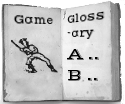Ball-Stock
| Game | Ball-Stock |
|---|---|
| Game Family | Baseball |
| Location | Germany |
| Regions | Europe |
| Eras | 1800s, Predecessor |
| Invented | No |
| Tags | |
| Description | per Dick, 1864. A team game like rounders, but having large safety areas instead of posts or bases. A feeder makes a short gentle toss to a batter, who tries to hit it. The batter-runner then chooses whether to run for a distant goal-line or a nearer one, for which there is a smaller chance of being plugged. The nearer station can hold several runners at once. Three missed swings makes an out, as does a caught fly. Versions of Ball-Stock are found in British and American boys’ books in the mid-Nineteenth Century. From another source: BALL-STOCK, or Ball-stick, is, as its name would indicate, a German game, but in some respects resembles our favorite English sport of "Rounders." The players are divided into two parties; six bases are then marked out, as in the accompanying Diagram; and for the first " innings" the players toss up. C _l_l_l_l_l_l_l_ D E (.) F A _l_l_l_l_l_l_l_ B l l l c b a The in-players occupy the "home" — A to B; the out-players station themselves as in Cricket, having one boy as feeder who stands at a, and another at c who acts as wicket-keeper, and tosses back the ball when tipped or missed. The striker stands at b. The ball having been thrown, and, we will suppose, well hit by the striker, he runs off to the base C — D, touching on his way at the resting base E — F; but if he has only tipped the ball, or struck it but a very short distance, or if it is stopped by one of the out-players, he should make off at once for the resting base E — F, and remain there until relieved by one of his fellow-players, whose fortunate hit may drive the ball so far out of range as to enable him to escape to C — D, or even run " home." If struck with the ball on his way from one base to another, he goes out. The other regulations are the same as in "Rounders." From Elliott, The Playground and the Parlour (1868), p. 57 |
| Sources | Dick, ed., The American Boys Book of Sports and Games: A Practical Guide to Indoor and Outdoor Amusements (Dick and Fitzgerald [reprinted by Lyons Press, 2000], 1864)., pages 112-113. Elliott, The Playground and the Parlour (1868), p. 57. |
| Source Image | [[Image:|left|thumb]] |
| Comment | Edit with form to add a comment |
| Query | Edit with form to add a query |
| Has Supplemental Text |
Comments
<comments voting="Plus" />
